Have you heard about WordPress? If you want to create a blog with WordPress, you first know about it. WordPress, in its beginnings, was developed to work in “blog” format, and since then, it has become the best platform for blogs par excellence. Many other platforms can “work” as a blog, but none with the capacity, simplicity, and originality offered by WordPress.
What is a Blog?
I’ll give you an example: Have you ever heard of the “captain’s blog,” where he usually has a book in which he writes about the adventures that happen on the high seas while sailing? Another example would be social networks. These work as blogs on other platforms and have different functions, but basically, they are blogs. These would be some simple ideas of what a blog can be.
Wikipedia offers a broader definition of what a blog is, and a summary could be something like this:
A blog is a website where one or several authors publish a series of articles in reverse chronological order (the most recent that has been published is the first thing that appears) in text format, images, videos, or a combination of them, classified by categories and different themes, giving the possibility to readers to participate through comments.
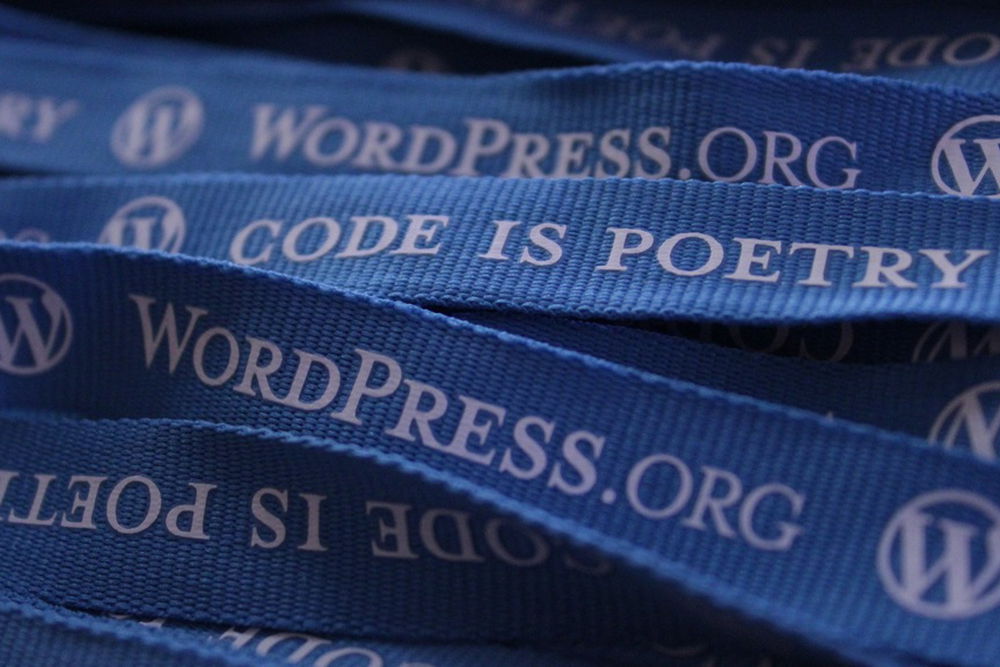
1. Requirements to Create a Blog with WordPress
It will be necessary to meet the following requirements to create a blog with WordPress:
To install WordPress, you need a domain and a server. Previously, it was recommended to use a local server. Still, its use is not recommended because it usually causes many problems with operating systems, and some plugins do not work locally. Using a remote server (online) with which you can perform tests is advisable. You can use the server that I recommend in the free hosting article. You can buy a domain and hosting for one year to start your project with WordPress.
Download WordPress from wordpress.org.
Install WordPress on the remote server. This article provides all the information you need to create a WordPress blog from scratch.
Once you have installed WordPress, log in with the username and password you created and access the WordPress administration panel.
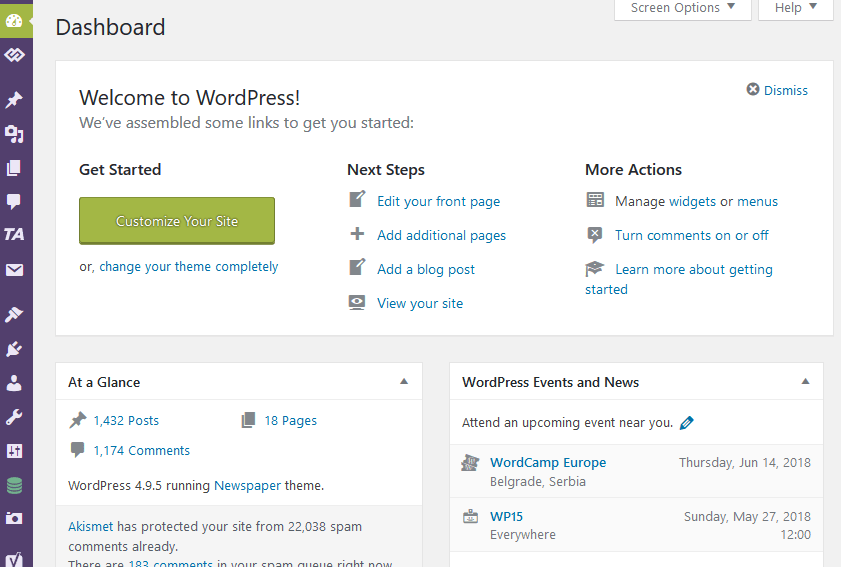
2. WordPress Configuration and Administration Panel
In the article on what to do after installing WordPress, you have explained the basic configuration of a WordPress installation in detail. This configuration is valid for using WordPress as a page, for the blog, and even for creating an online store.
To create a more optimized blog, read the article plugins for WordPress. I recommend setting up the Custom Permalinks and Yoast SEO plugins. Then, read the article and learn to create a blog entry already optimized for SEO.
Learn how to install and activate WordPress plugins.
3. Use of Categories and Tags in WordPress
When you create a blog with WordPress, I’ll illustrate an example to help you better understand the use of categories and tags. Although it may seem “simple,” the correct use of categories and tags can make a difference in SEO and, more importantly, how your users feel comfortable navigating your blog (usability).
Imagine that you are going to create a blog with WordPress about means of transport. You can use more generic categories, such as cars, motorcycles, ships, and airplanes, to classify articles.
For tags, you could use “Audi,” “BMW,” “Ferrari,” or “Renault” since they are more specific and can be used for several articles with different categories.
Start by writing a high-end car article. The entry’s title could be: The new high-end cars consume less fuel. You can assign it as a category Cars and as Audi, BMW, and Ferrari tags.
If you notice, the category classifies the article, while the tags classify the article and category.
3.1 Categories and Tags Management
Another thing you should know is that every time you write an article, you can assign existing categories and tags. Once created, WordPress will show you the categories and tags you have already made so you can assign them, although it will also give you the option to create new ones. WordPress is very versatile and functional.
We are returning to the previous example. Now, you want to create an article that talks about motorcycles. You could not assign the category “cars” because it has nothing to do with motorcycles, but you could create a new category: Motorcycles. As for the labels, you could assign the tag “BMW” that you used for the car article since BMW, in addition to cars, also sells motorcycles. Additionally, for example, you can create other new labels such as “Yamaha”, “Honda” and “Suzuki”. As with tags, several categories can be assigned to the same article.
The main function of the categories is to classify the articles into sections so that you can use them in the menu of your blog. The tags work as “internal links” that help to link the articles among them by theme and, its “good use”, is recommended in SEO. Recommendation: do not abuse the use of the labels because you could be penalized.
Learn How to Take Advantage of WordPress for Your Website.
4. Create a Post in WordPress
Continuing with the previous example of high-end cars, create the post and assign the corresponding categories and tags.
In the WordPress admin panel, go to Posts >> Add new. Then, learn about the new WordPress Block Editor Gutenberg.
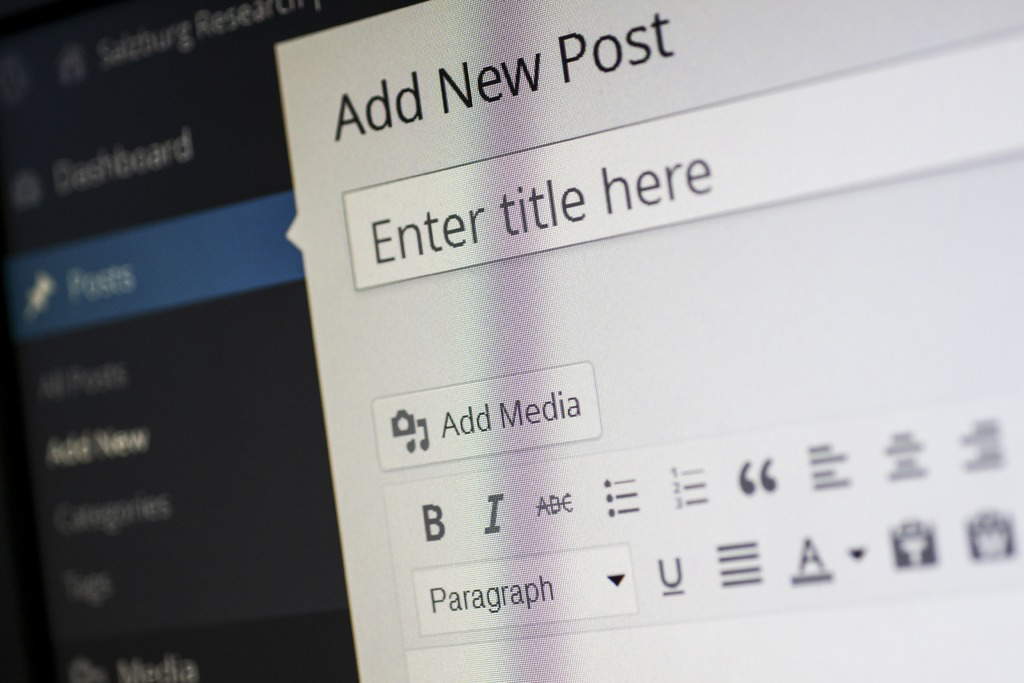
Write the title New high-end cars consume less fuel in the field. Enter the title here. If you notice, WordPress does not show you anything under the title field. In that space should appear the URL of the page, but until you write a title, WordPress will not show you anything since, by default, it will assign one related to the title.
You would have something like this:
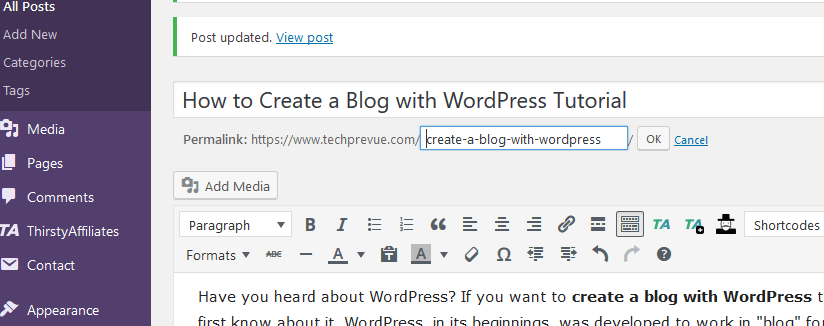
Notice that a new field has appeared under the title, Permalink, which will be the friendly URL that WordPress assigns to the article based on the title. In addition, in the Yoast SEO box, the title has been added and shows you how it will appear in Google results. On the right side of the screen, you will see the following sections:
4.1 Publish
This box controls how the post is published when you create a blog with WordPress. You can save the article as a draft before publishing it, make it public, private, or password-protected, and change the publication date (before the date you have written or later if you want to schedule it to be published on another date).
4.2 Format
This controls how the entry’s content will be displayed. You can get more information at https://codex.wordpress.org/Post_Formats. By default, the standard format type is used.
4.3 Categories
By default, WordPress comes with a category “Uncategorized,” which can not be deleted but modified. This is assigned to an entry if the author has not created or assigned any category for the post since it does not make sense that a post is without an assigned category.
4.4 Tags
This is where you will create and assign the tag(s) to the entry. It is not obligatory to use them, but it is highly recommended.
4.5 Featured image
This is where you will upload the main image of the article. It is usually displayed in the blog entries or categories list in the Blog section. Depending on the type of template you are using, this image may be displayed in one way or another.
Continuing with the example, leave the first two boxes by default, and in Categories, click on “+ Add new category,” type Cars, and click on the Add new category button. You will see the new category created in the list of categories and marked checked.
In Tags, type Audi, BMW, and Ferrari separated by a comma as indicated and click the Add button. You’ll see that these labels now appear in the box.
Then, go to the WordPress text editing box. I explain how to write with this text editor.
Start writing the content of the entry, and it will look something like this:
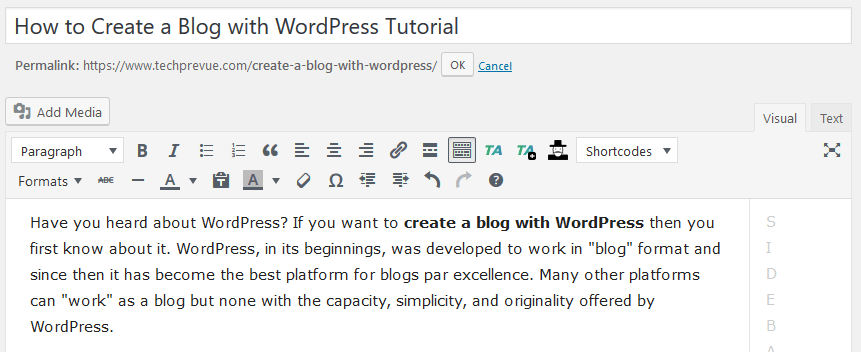
Once you have the written content, you will see that something more is needed—an image! Find an image related to the content. Find yourself in the part of the content where you want this image to appear. It can be between the first and second paragraph.
4.5.1 Add Media
You will see a button above the WordPress text editor, Add Media. Click on the button, and you will see the following:
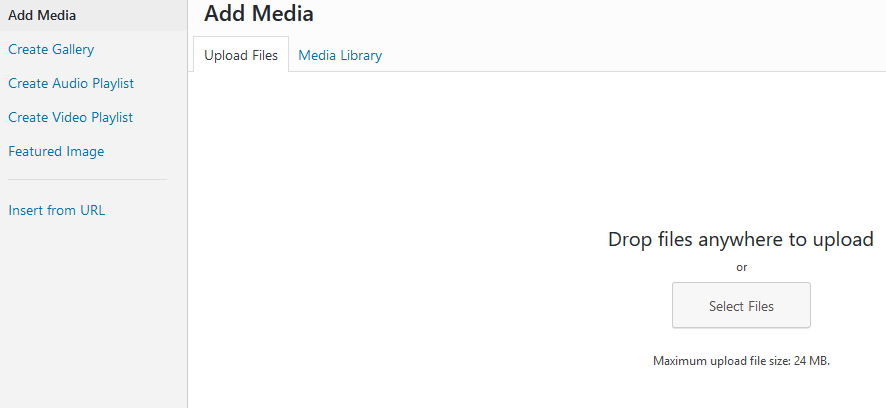
You select it from your PC and drag it to the WordPress screen.
You click the “Select files” button, search for it on the PC, and upload it.
Very important: before uploading an image to WordPress, it is recommended that you name it, taking into account the following rules:
Let the title be written in all lowercase letters. Try to match the title of the article: the-new-cars-of-high-range-consume-less-fuel.jpg.
The image has a JPG extension. JPG images are smaller than PNG images and help with the page’s loading speed, although PNG images have better resolution.
Let each word be separated by dashes (without spaces) and without accents (accents).
No word has symbols or special characters like the letter “ñ.” If a word has “ñ,” you can write the letter “n” instead.
Once you do any of these two actions, you will see something like this:
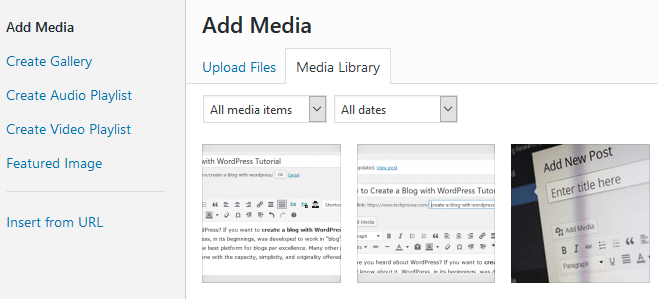
4.5.2 Image SEO
Before inserting the image in the post, you will see other fields that you have to take into account:
Title: By default, it shows you the name you have given to the image. You can change it to a title that matches the post’s content.
Alternative text: This field is the most important because it is known as the ALT tag, a parameter of the images that must always be considered for SEO and that Google likes a lot. You can read the post about titles and alt tags, one of the guidelines for Google Webmasters that you must respect. You can write the same as in the title.
Alignment: you can leave it as you like.
Linked to: I recommend that you do not link it with anything to prevent the image from being indexed erroneously or that in the future it will be deleted and generate a 404 page in the blog; Google s not like this.
Size: Try to use a more or less appropriate dimension so that the image does not leave the margins of the space designated by the template. You can resize the image before uploading it.
4.5.3 Insert Image to Post
To clarify these points, click the Insert button in the post. Your image will now appear within the text field and the text you previously wrote. Now go to the side box Featured image and select the same image that you just uploaded.
The URL will be the following: new-cars-of-high-range-consume-less-fuel/. WordPress has most likely assigned this URL.
It is important to remember that the words are separated with hyphens. Never leave blank spaces in a URL because they will be misinterpreted by browsers, and do not write the words with accents (accents) in a URL even if they are in the title.
Also, do not use symbols or special characters such as the letter “ñ.” If a word carries “ñ,” use the letter “n” instead. Let WordPress do its job.
The URL is very similar to the title. Google recommends that URLs be as short as possible but accurate.
5. Setting up Post Metadata with the Yoast SEO plugin
Finally, you have to assign the metadata in the Yoast SEO plugin. In the Yoast SEO box, click on the Edit snippet button, and you will see the following fields:
SEO Title: Yoast SEO will assign the same entry title, so it is best to leave it blank.
Slug: This corresponds to the post’s URL assigned to the plugin once you post it.
Meta description: Write a meta description of the post. Try not to exceed the 240 to 360 characters that Google shows in your search results.
The first and third fields are the most important for correct SEO. Keep in mind that Google shows the SEO Title and meta description in the search results, and these depend on whether your post is correctly positioned.
In the SEO article for WordPress, you have a complete guide to configuring SEO on your blog.
Having all this configured, it would be as follows:
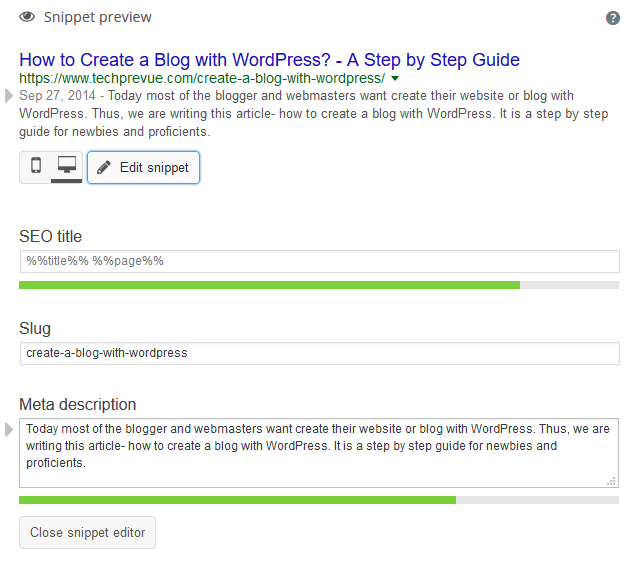
6. Publishing the Post
Check that everything is correctly configured and that you have written your article well, and check the spelling of the text. Click on the Publish button, and the entry will be published. You will see a View Post button next to the “Permalink” field. Click on this button to see the result in the WordPress Front End.
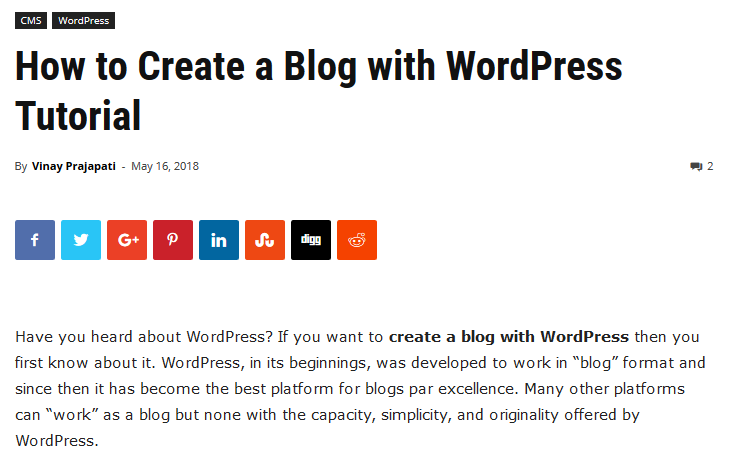
Now that you have published your post, go to the Posts section, and you will see that the entry created with all its parameters appears.
Important Notes for Correct Optimization and SEO
As I mentioned in the previous points, it is essential to respect specific rules that Google indicates in its webmaster guidelines for correctly positioning your posts and blog in general. Google has created several important rules, but some details are missing. However, they are still important, and I’ll tell you here.
1. Plugins
At the beginning of the article, I recommended that you work on installing WordPress on a remote server and use the Custom Permalinks and Yoast SEO plugins, which are more than enough for a good SEO of your blog.
2. URLs
You have already seen that when creating the entry, and thanks to the Custom Permalinks, it is possible to assign a custom URL. Remember not to use accents in words, separate the words with hyphens (-) without leaving blank spaces, and do not use special characters or the letter “ñ.”
3. Titles and descriptions
With the Yoast SEO plugin, you can assign a title and a description to position your entry. Keep in mind you do not exceed the character limit. The plugin will automatically tell you when you exceed characters.
4. Categories
When you have created the category “Cars,” WordPress, by default, creates a URL for this category/cars/. Note that you have prefixed the category/prefix before the category name. This is done to avoid repeated URLs that are PROHIBITED by Google and that there is no point in their existence.
It is correct that WordPress uses this prefix before the name of each category you have created, but this is not pleasant for positioning and is not very aesthetic. Thanks to the magic of the Custom Permalinks, it is possible to clean the URL of the categories in the following way:
- Go to Posts > Categories within the WordPress Dashboard
- You will see a list of the categories you have created. Click on the category you want to modify. In this case, Cars.
- In the Custom Permalink section, you will see that it shows you the domain. The next field, category/cars/, is what you will modify. Delete category/so that only cars remain, which will be the final URL. Be careful when doing this action because you could repeat some categories or, even worse, confuse the URL of a category with an entry.
- Click Update to modify the URL of the category.
5. Tags
It works the same as with the categories but prefixing the tag. The procedure for its modification is the same as for the categories, although modifying the URLs of the tags is not very important. You can leave them as they are.
It is highly recommended not to index the tags for SEO since each tag creates a URL. Doing so can lead to duplicate content on your blog, which Google penalizes. So, in summary, do not index the tags. You can do this through the Yoast or any SEO plugin you use.
Final words
You no longer have an excuse to start creating a blog with WordPress. There are many details and configurations, but it is worth carrying them out. Keep in mind that it’s useless to write a blog and share it if nobody knows it exists. Thanks to the “magic of SEO,” complying with Google’s basic rules, and using social networks, you can make your blog known to people worldwide.

It is very important information about creating a WP blog.
Most welcome Mr. Kailash!
Amazing information for techlovers
Thanks for the step by step guide. what was a little difficult to understand is now easy.
Thanks for sharing this great post
This step by step guide for wordpress is very helpful in creating my site. Thanks a lot…